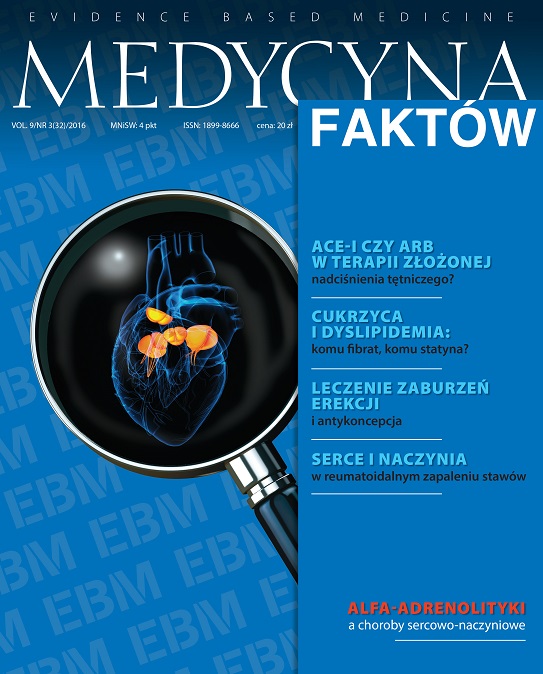Kliniczne profile pacjentów z nadciśnieniem tętniczym, u których warto rozważyć terapię skojarzoną telmisartanem i hydrochlorotiazydem Artykuł przeglądowy
##plugins.themes.bootstrap3.article.main##
Abstrakt
Telmisartan to nowoczesny, długo działający sartan, charakteryzujący się działaniem metabolicznym, szczególnie wskazany u osób z wysokim ryzykiem sercowo-naczyniowym. Dołączenie do telmisartanu małej dawki tiazydowego leku moczopędnego (hydrochlorotiazydu) poprawia skuteczność leczenia hipotensyjnego i nie zwiększa istotnie częstości występowania działań niepożądanych. Terapia skojarzona telmisartanem i hydrochlorotiazydem możliwa jest przy użyciu preparatu złożonego, co upraszcza schemat leczenia i poprawia przestrzeganie zaleceń terapeutycznych.
##plugins.themes.bootstrap3.article.details##
Jak cytować
Wydra, W., & Kuch , M. (2016). Kliniczne profile pacjentów z nadciśnieniem tętniczym, u których warto rozważyć terapię skojarzoną telmisartanem i hydrochlorotiazydem . Medycyna Faktów , 9(3(32), 249-254. Pobrano z https://journalsmededu.pl/index.php/jebm/article/view/2231
Numer
Dział
Artykuły
Copyright © by Medical Education. All rights reserved.
Bibliografia
1. The Task Force for the management of arterial hypertension of the European Society of Hypertension (ESH) and of the European Society of Cardiology (ESC). 2013 ESH/ESC Guidelines for the management of arterial hypertension. Eur. Heart J. 2013; 34: 2159-2219.
2. Tykarski A., Narkiewicz K., Gaciong Z. et al.: Zasady postępowania w nadciśnieniu tętniczym – 2015 rok. Nadciśnienie Tętnicze w Praktyce 2015; 1(1): 1-70.
3. Charakterystyka produktu leczniczego. Telmisartan.
4. Neutel J.M.: Ambulatory blood pressure monitoring to assess the comparative efficacy and duration of action of a novel new angiotensin II receptor blocker-telmisartan. Blood Press. 2001; 10(4): 27-32.
5. Lacourcière Y., Tytus R., O’Keefe D. et al.: Efficacy and tolerability of a fixed-dose combination of telmisartan plus hydrochlorothiazide in patients uncontrolled with telmisartan monotherapy. J. Hum. Hypertens. 2001; 15(11): 763-770.
6. Lacourcière Y., Martin K.: Comparison of a fixed-dose combination of 40 mg telmisartan plus 12.5 mg hydrochlorothiazide with 40 mg telmisartan in the control of mild to moderate hypertension. Am. J. Ther. 2002; 9(2): 111-117.
7. Parati G., Bilo G., Redon J. et al.: The effects of telmisartan alone or with hydrochlorothiazide on morning and 24-h ambulatory BP control: results from a practice-based study (SURGE 2). Hypertens. Res. 2013; 36(4): 322-327.
8. Kjeldsen S.E., Schmieder R.E., Unger T. et al.: Telmisartan and hydrochlorothiazide combination therapy for the treatment of hypertension. Curr. Med. Res. Opin. 2010; 26(4): 879-887.
9. The ONTARGET Investigators: Telmisartan, Ramipril, or Both in Patients at High Risk for Vascular Events. N. Engl. J. Med. 2008; 358: 1547-1559.
10. Inoue T., Morooka T., Moroe K. et al.: Effect of telmisartan on cholesterol levels in patients with hypertension – Saga Telmisartan Aggressive Research (STAR). Horm. Metab. Res. 2007; 39(5): 372-376.
11. Vitale C., Mercuro G., Castiglioni C. et al.: Metabolic effect of telmisartan and losartan in hypertensive patients with metabolic syndrome. Cardiovasc. Diabetol. 2005; 4: 6.
12. Morimoto T., Gandhi T.K., Fiskio J.M. et al.: An evaluation of risk factors for adverse drug events associated with angiotensin-converting enzyme inhibitors. J. Eval. Clin. Pract. 2004; 10(4): 499-509.
13. Widecka K., Grodzicki T., Narkiewicz K.: Zasady postępowania w nadciśnieniu tętniczym – 2011 rok. Wytyczne Polskiego Towarzystwa Nadciśnienia Tętniczego. Nadciśnienie Tętnicze 2011; 15(4): 211-235.
14. Poon I.O.: Effects of antihypertensive drug treatment on the risk of dementia and cognitive impairment. Pharmacotherapy 2008; 28: 366-375.
15. Yusuf S., Diener H., Sacco R.L. et al.: Telmisartan to prevent recurrent stroke and cardiovascular events (PRoFESS). N. Engl. J. Med. 2008; 359: 1225-1237.
16. ATHOS Study Group: Telmisartan plus HCTZ vs. amlodipine plus HCTZ in older patients with systolic hypertension: results from a large ambulatory blood pressure monitoring study. Am. J. Geriatr. Cardiol. 2006; 15(3): 151-160.
2. Tykarski A., Narkiewicz K., Gaciong Z. et al.: Zasady postępowania w nadciśnieniu tętniczym – 2015 rok. Nadciśnienie Tętnicze w Praktyce 2015; 1(1): 1-70.
3. Charakterystyka produktu leczniczego. Telmisartan.
4. Neutel J.M.: Ambulatory blood pressure monitoring to assess the comparative efficacy and duration of action of a novel new angiotensin II receptor blocker-telmisartan. Blood Press. 2001; 10(4): 27-32.
5. Lacourcière Y., Tytus R., O’Keefe D. et al.: Efficacy and tolerability of a fixed-dose combination of telmisartan plus hydrochlorothiazide in patients uncontrolled with telmisartan monotherapy. J. Hum. Hypertens. 2001; 15(11): 763-770.
6. Lacourcière Y., Martin K.: Comparison of a fixed-dose combination of 40 mg telmisartan plus 12.5 mg hydrochlorothiazide with 40 mg telmisartan in the control of mild to moderate hypertension. Am. J. Ther. 2002; 9(2): 111-117.
7. Parati G., Bilo G., Redon J. et al.: The effects of telmisartan alone or with hydrochlorothiazide on morning and 24-h ambulatory BP control: results from a practice-based study (SURGE 2). Hypertens. Res. 2013; 36(4): 322-327.
8. Kjeldsen S.E., Schmieder R.E., Unger T. et al.: Telmisartan and hydrochlorothiazide combination therapy for the treatment of hypertension. Curr. Med. Res. Opin. 2010; 26(4): 879-887.
9. The ONTARGET Investigators: Telmisartan, Ramipril, or Both in Patients at High Risk for Vascular Events. N. Engl. J. Med. 2008; 358: 1547-1559.
10. Inoue T., Morooka T., Moroe K. et al.: Effect of telmisartan on cholesterol levels in patients with hypertension – Saga Telmisartan Aggressive Research (STAR). Horm. Metab. Res. 2007; 39(5): 372-376.
11. Vitale C., Mercuro G., Castiglioni C. et al.: Metabolic effect of telmisartan and losartan in hypertensive patients with metabolic syndrome. Cardiovasc. Diabetol. 2005; 4: 6.
12. Morimoto T., Gandhi T.K., Fiskio J.M. et al.: An evaluation of risk factors for adverse drug events associated with angiotensin-converting enzyme inhibitors. J. Eval. Clin. Pract. 2004; 10(4): 499-509.
13. Widecka K., Grodzicki T., Narkiewicz K.: Zasady postępowania w nadciśnieniu tętniczym – 2011 rok. Wytyczne Polskiego Towarzystwa Nadciśnienia Tętniczego. Nadciśnienie Tętnicze 2011; 15(4): 211-235.
14. Poon I.O.: Effects of antihypertensive drug treatment on the risk of dementia and cognitive impairment. Pharmacotherapy 2008; 28: 366-375.
15. Yusuf S., Diener H., Sacco R.L. et al.: Telmisartan to prevent recurrent stroke and cardiovascular events (PRoFESS). N. Engl. J. Med. 2008; 359: 1225-1237.
16. ATHOS Study Group: Telmisartan plus HCTZ vs. amlodipine plus HCTZ in older patients with systolic hypertension: results from a large ambulatory blood pressure monitoring study. Am. J. Geriatr. Cardiol. 2006; 15(3): 151-160.
